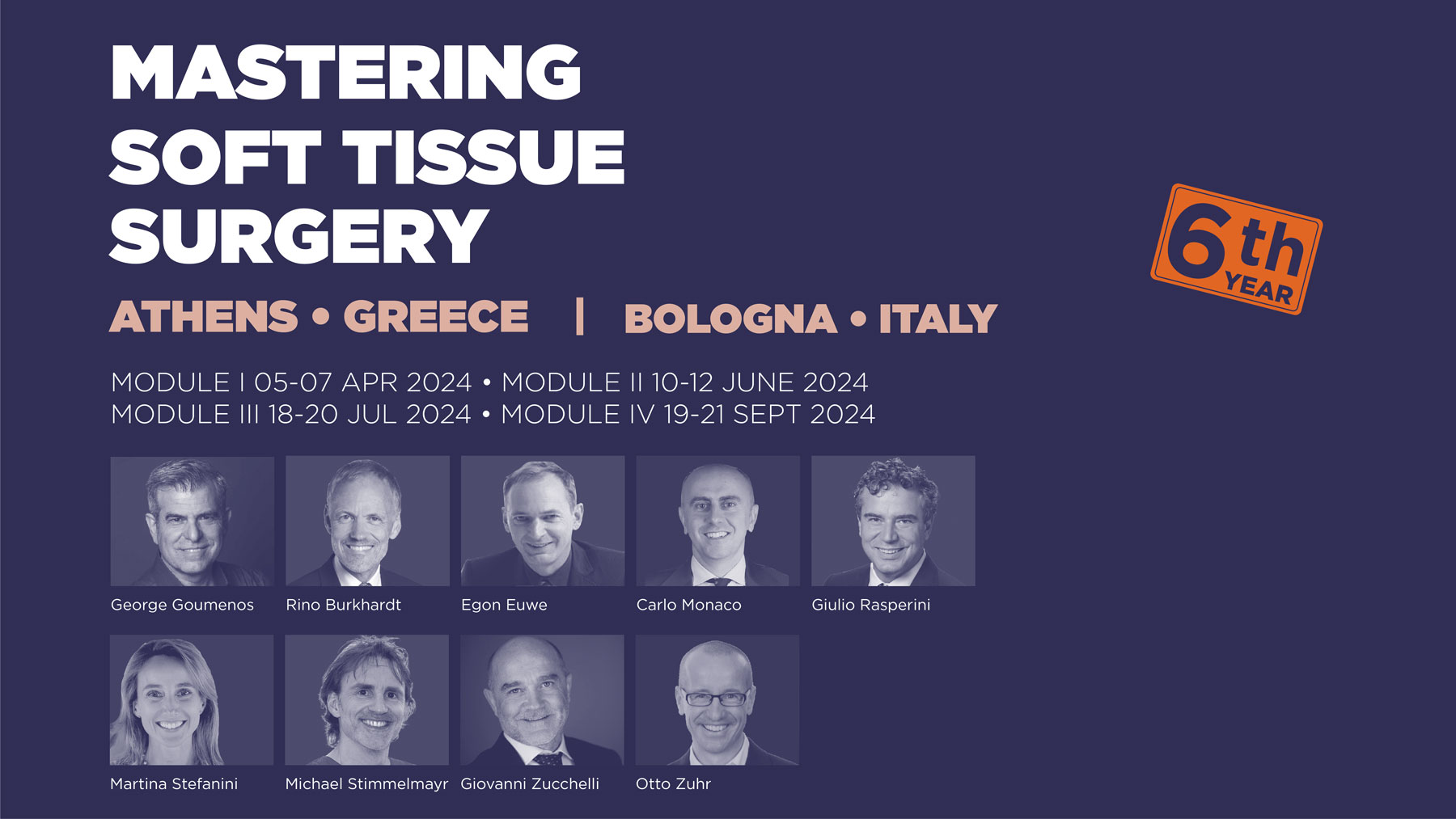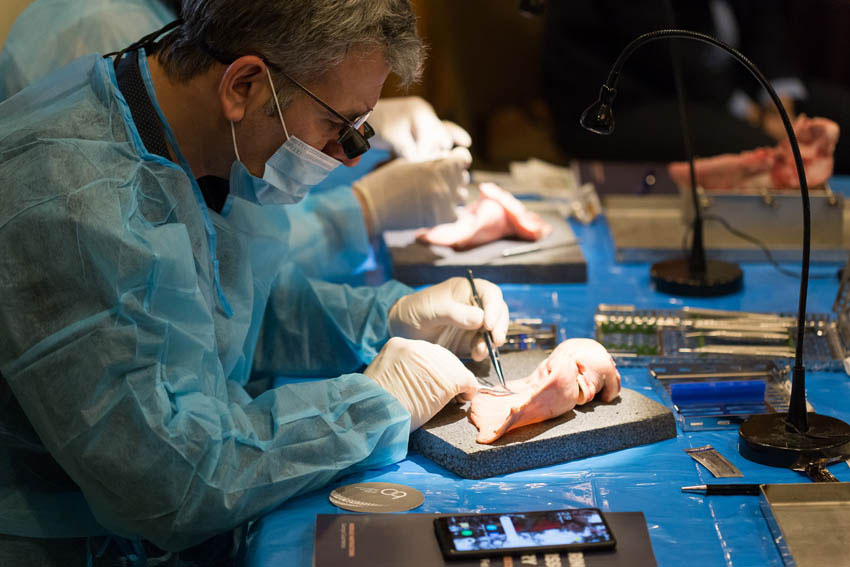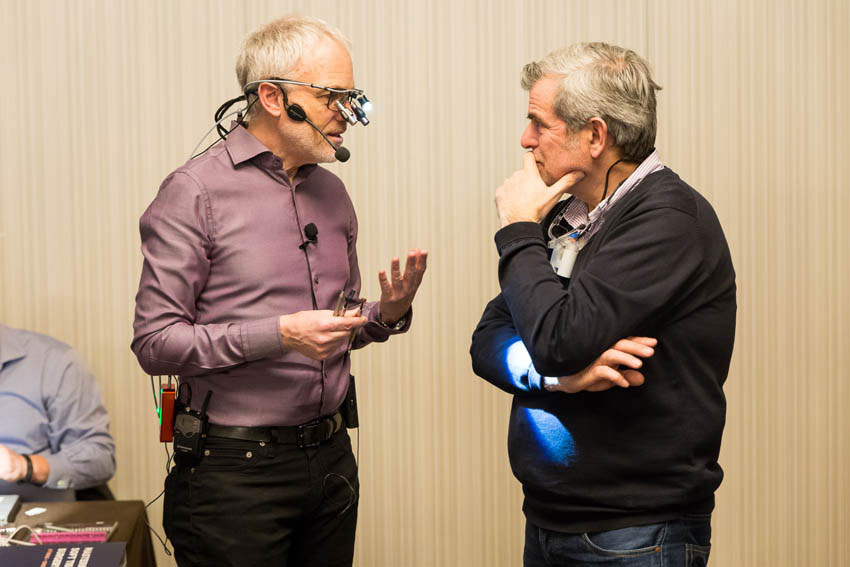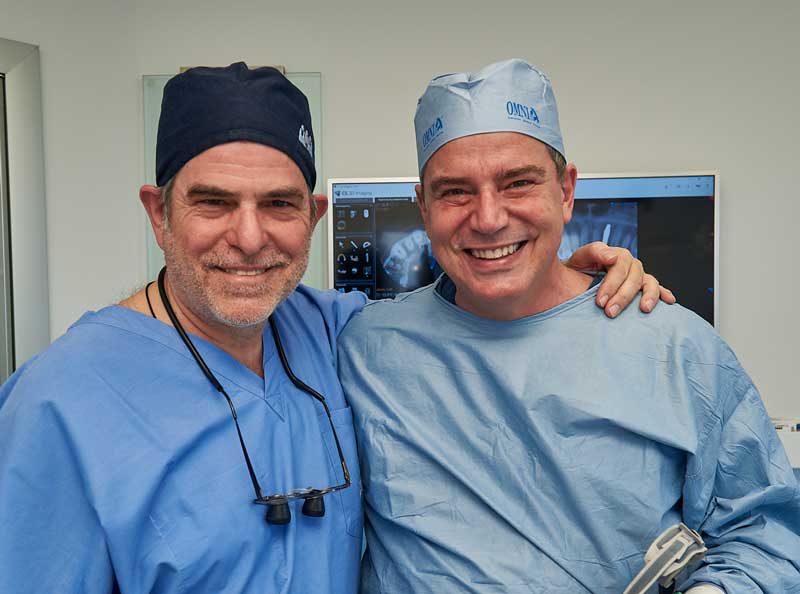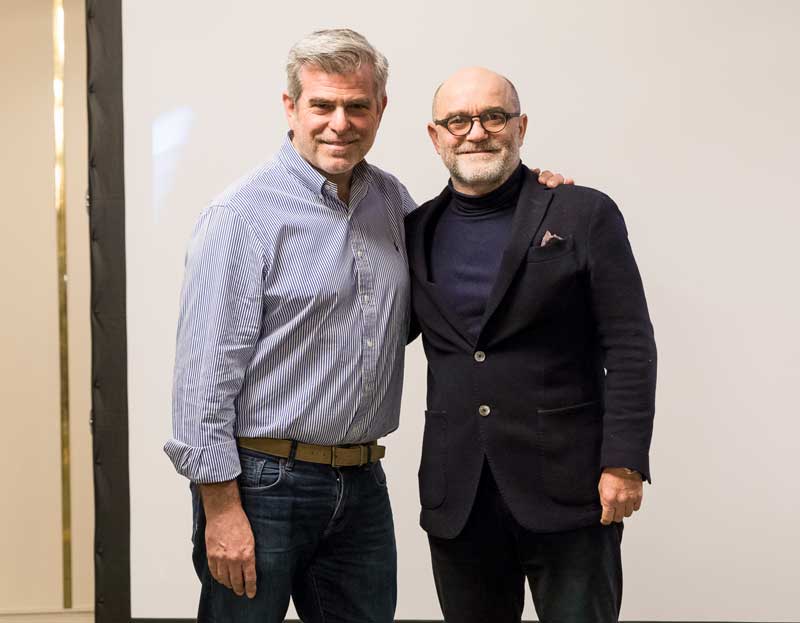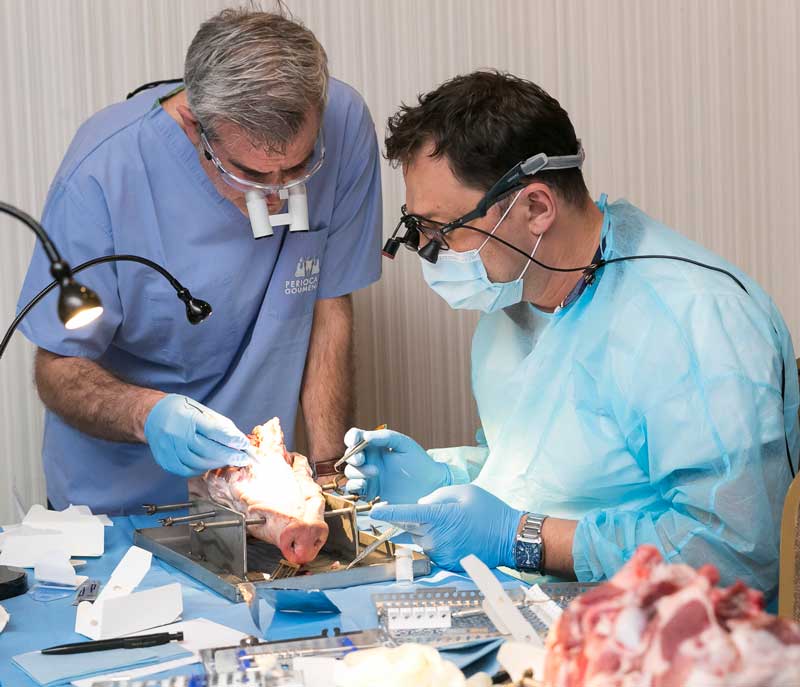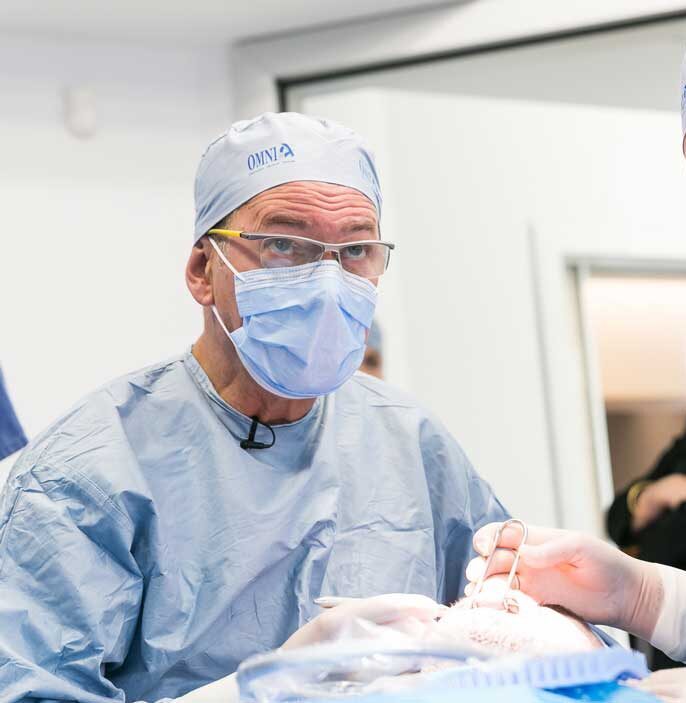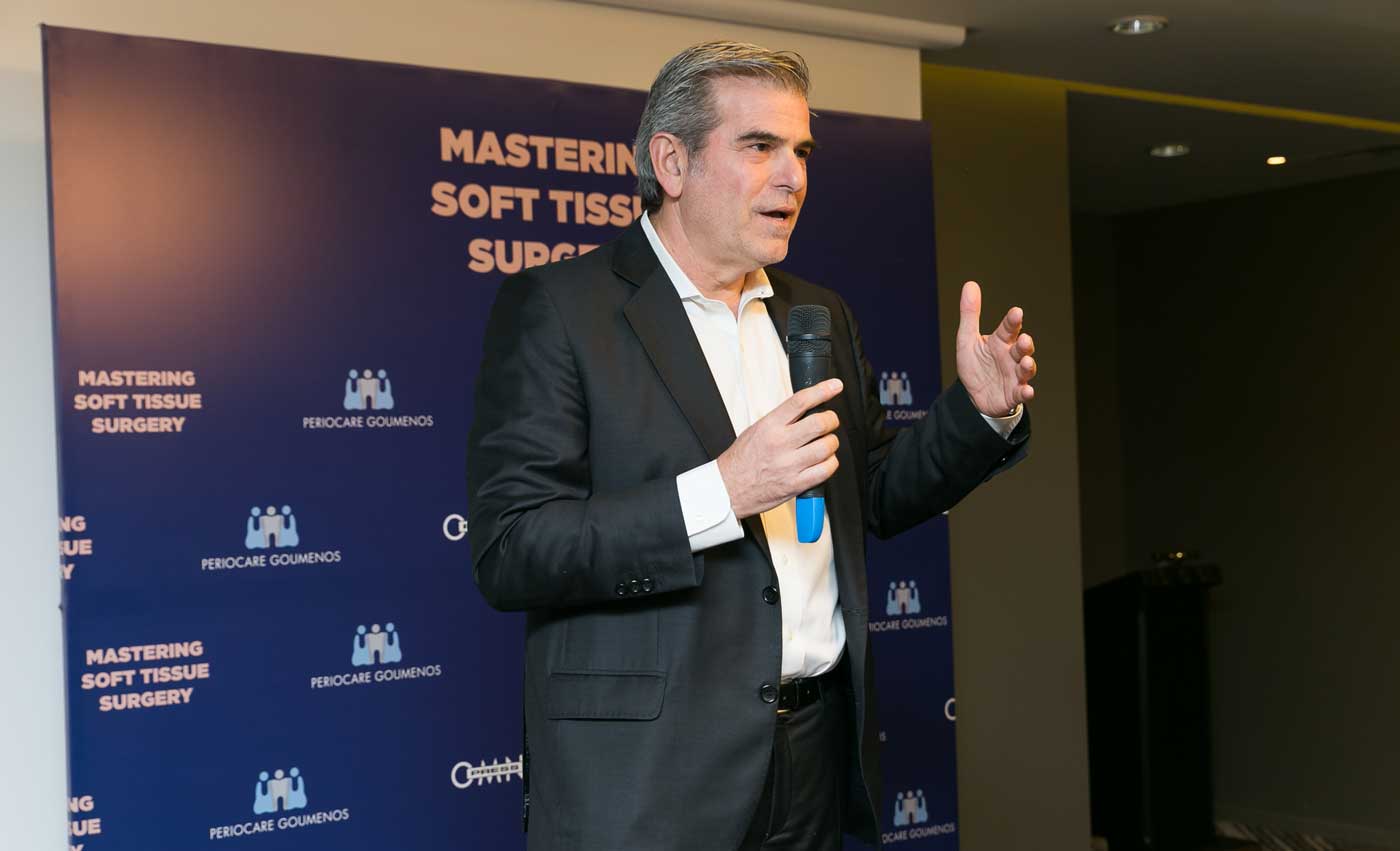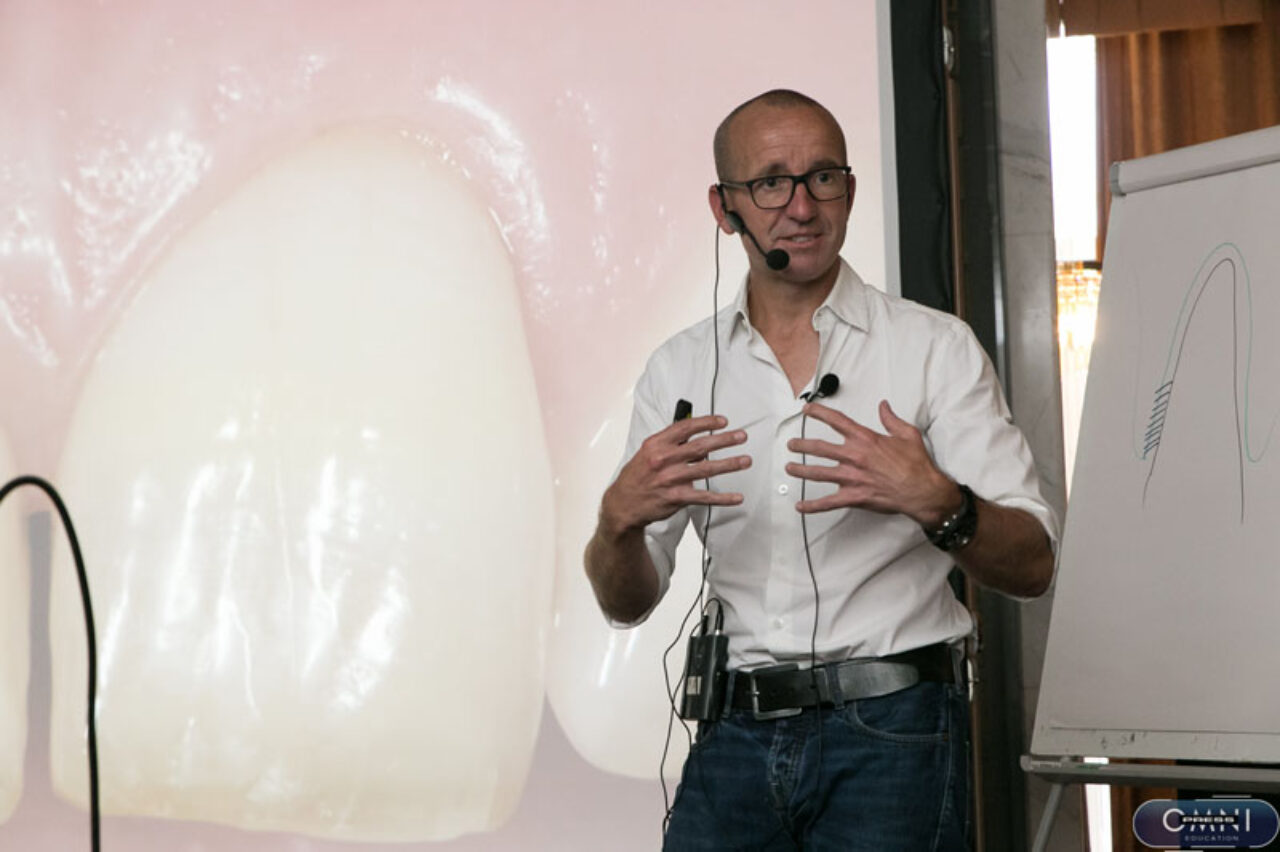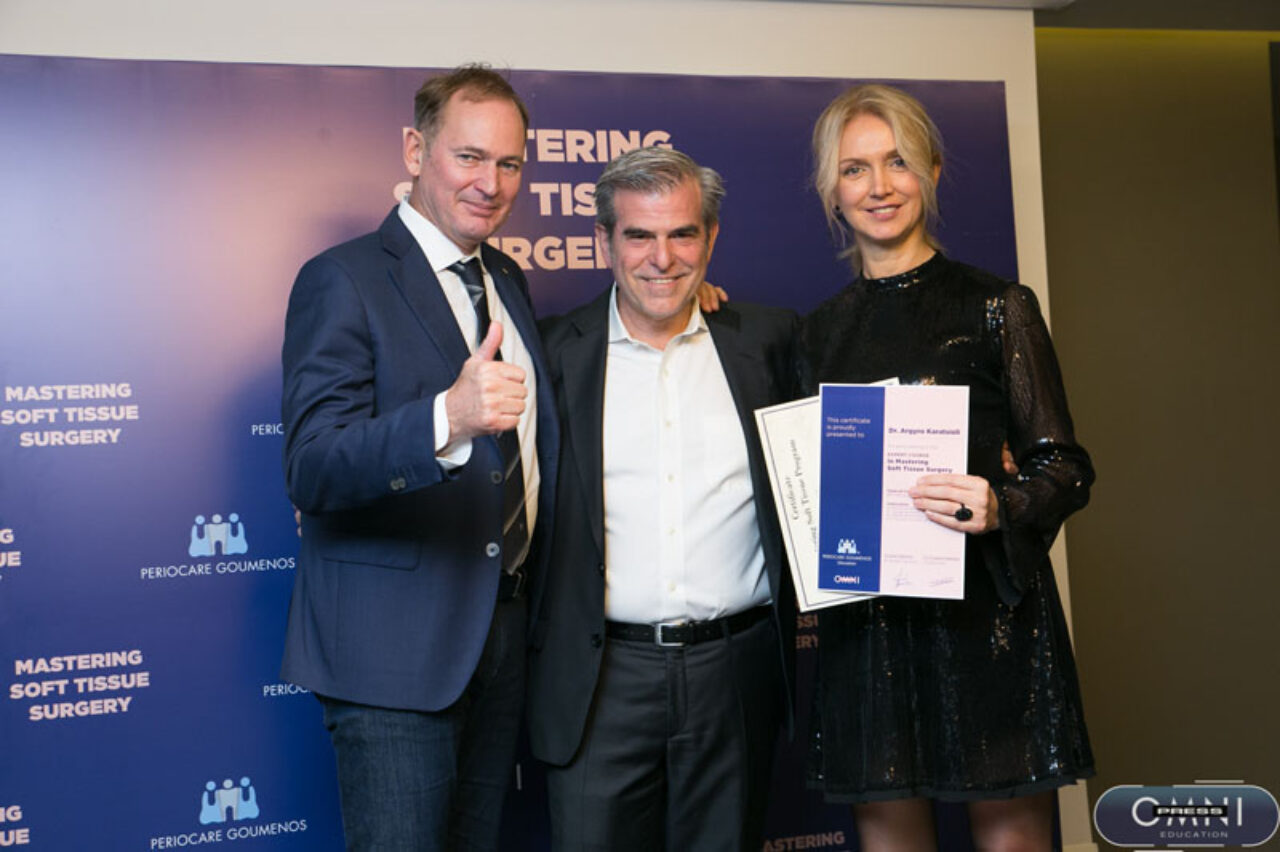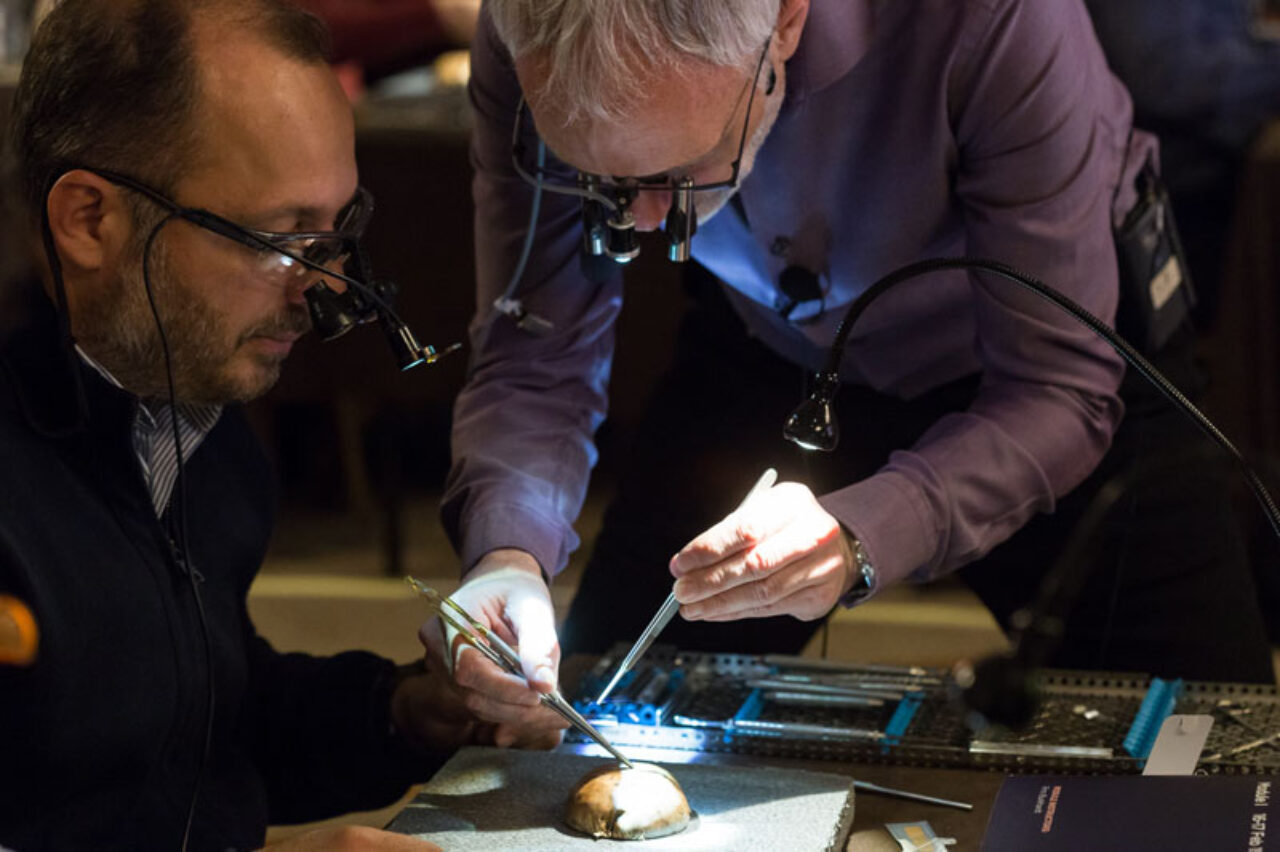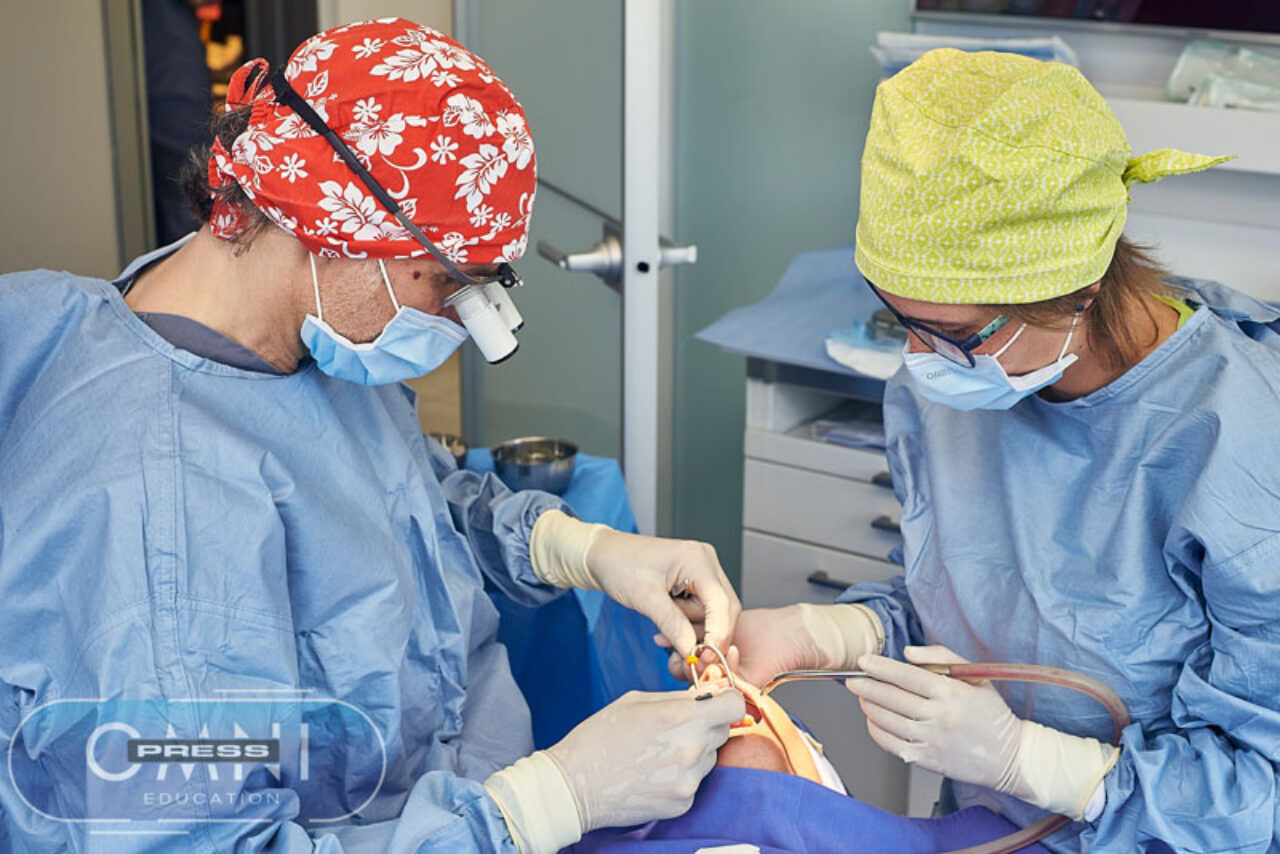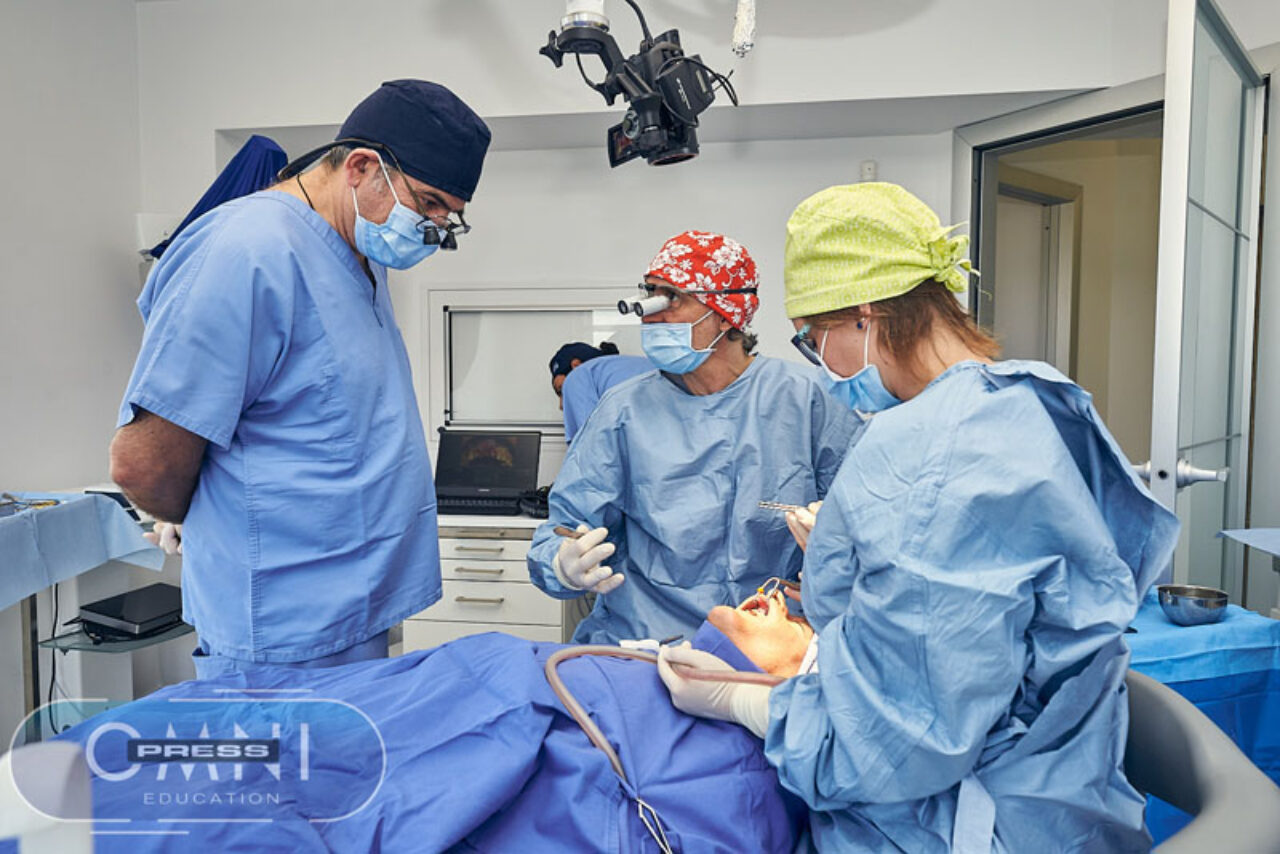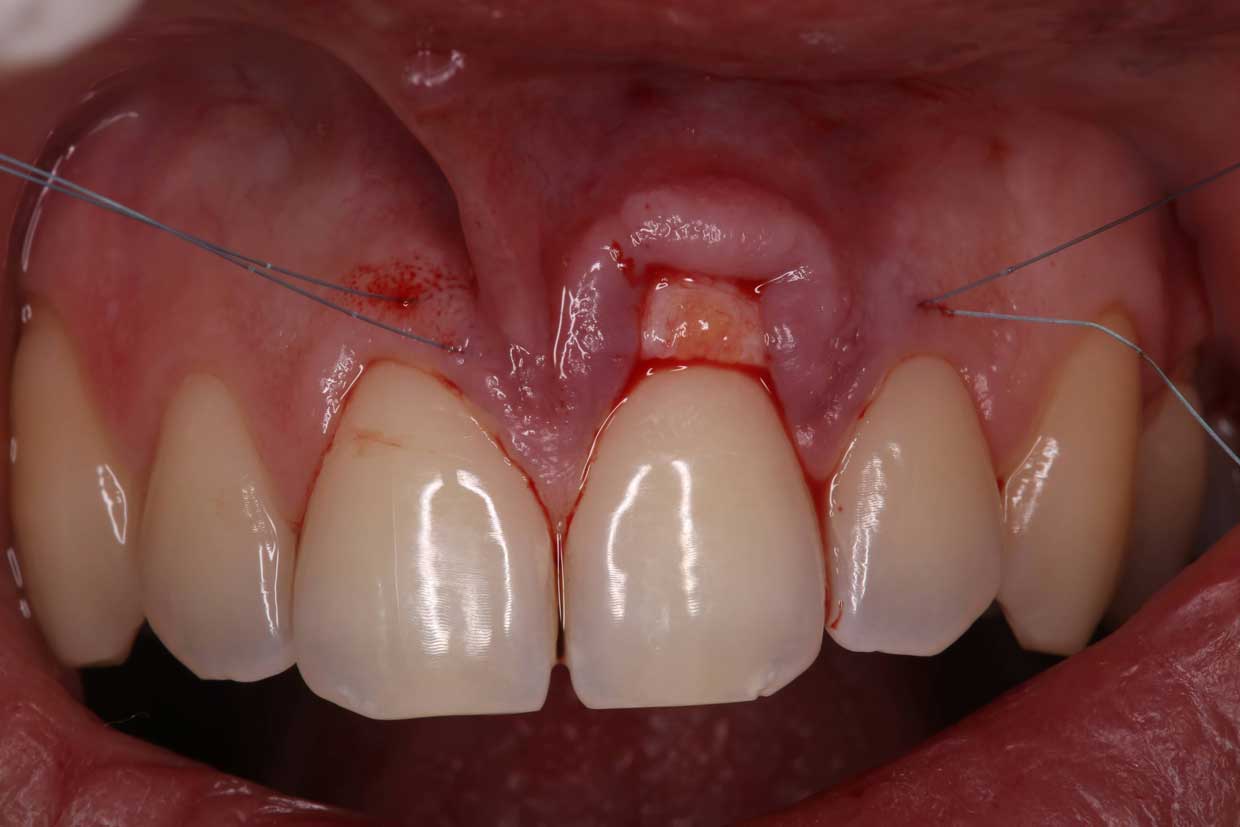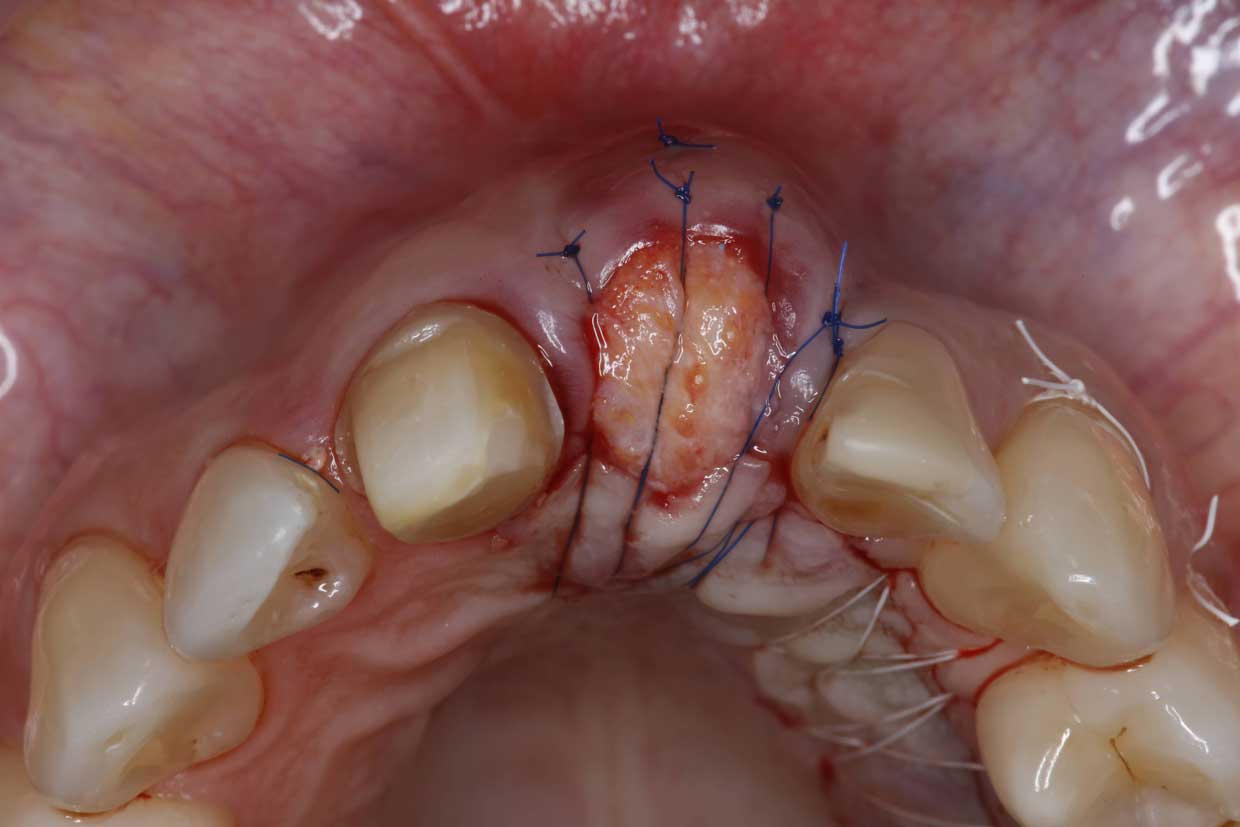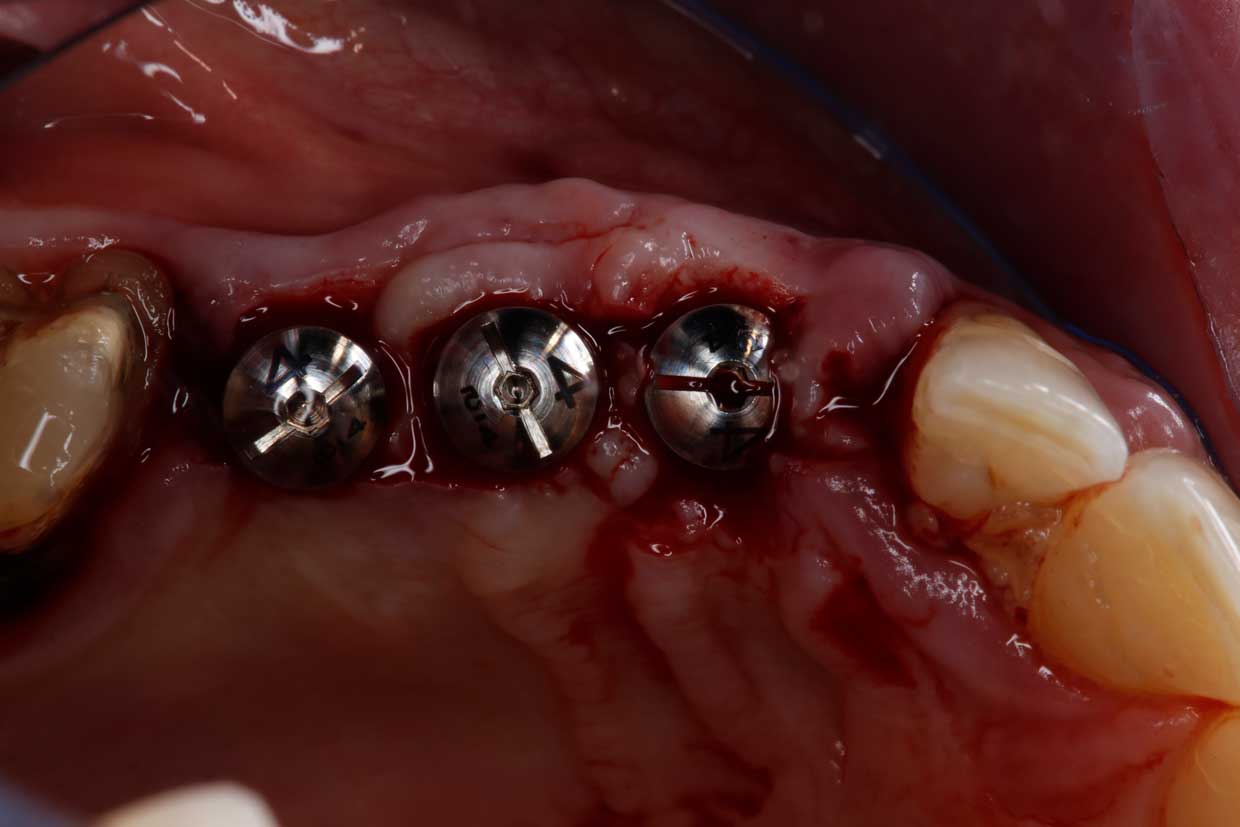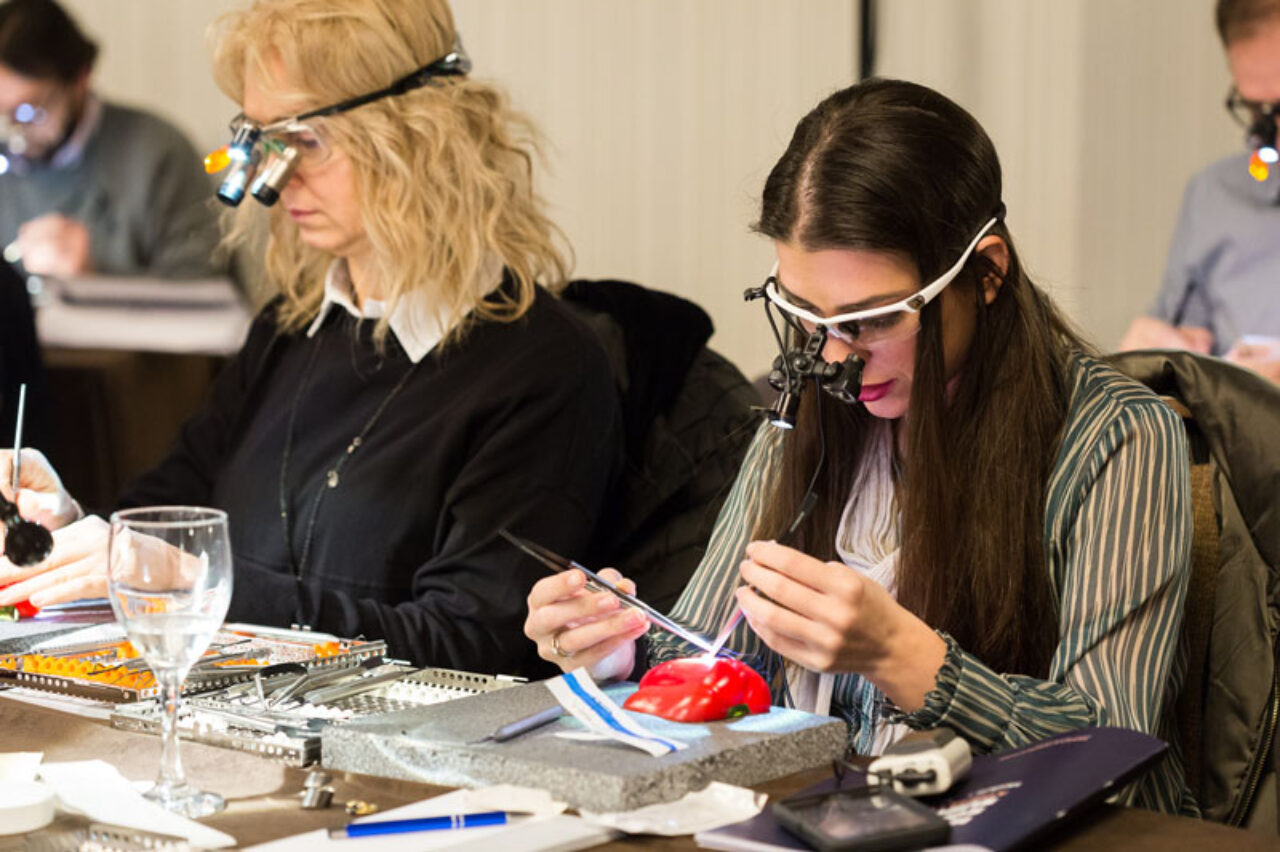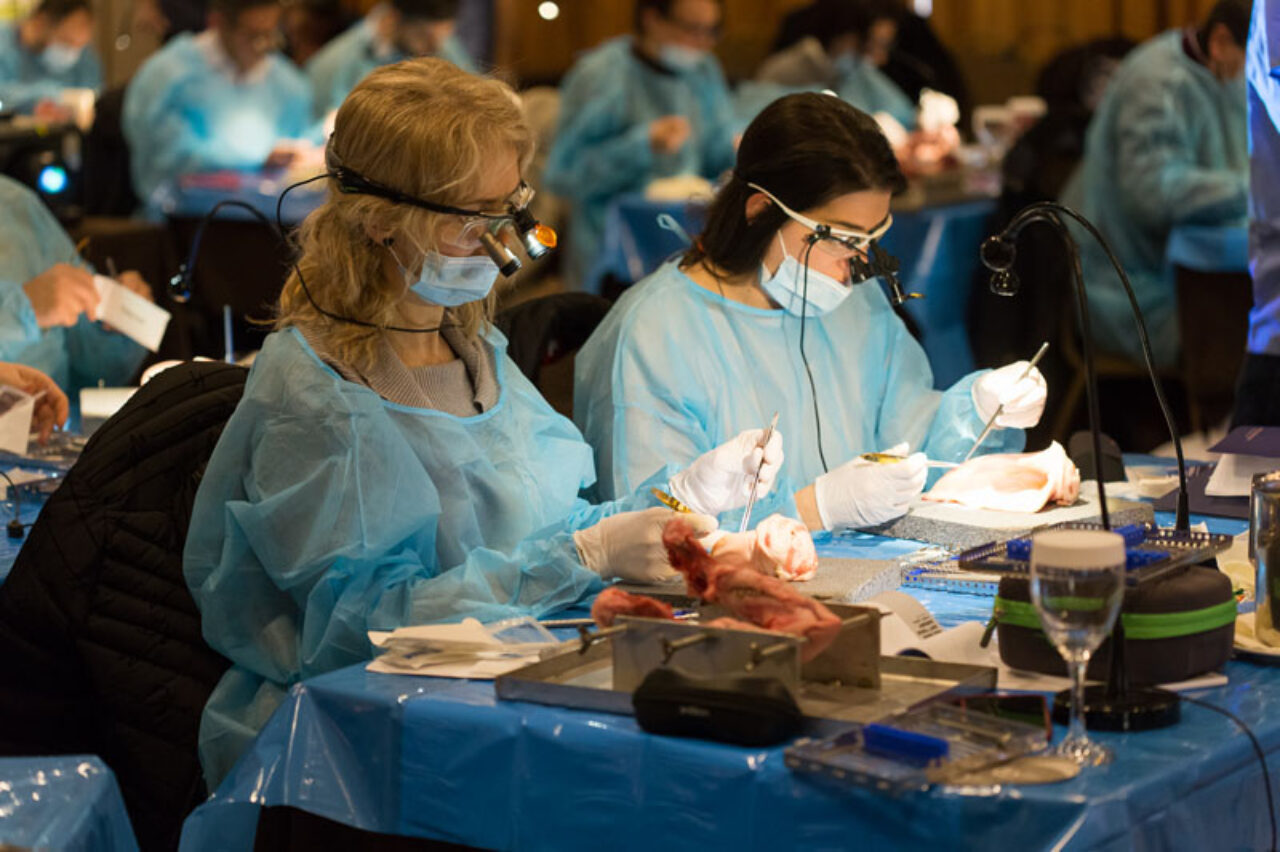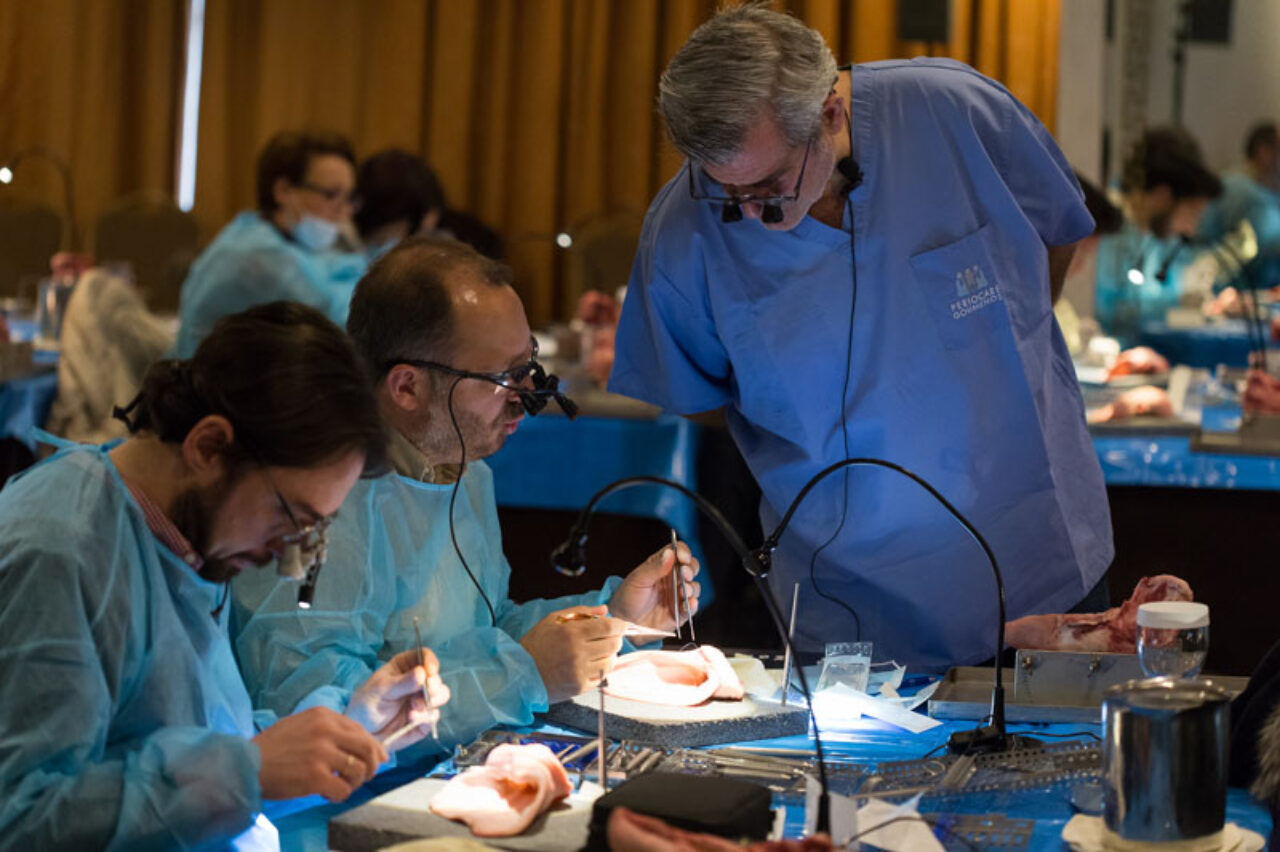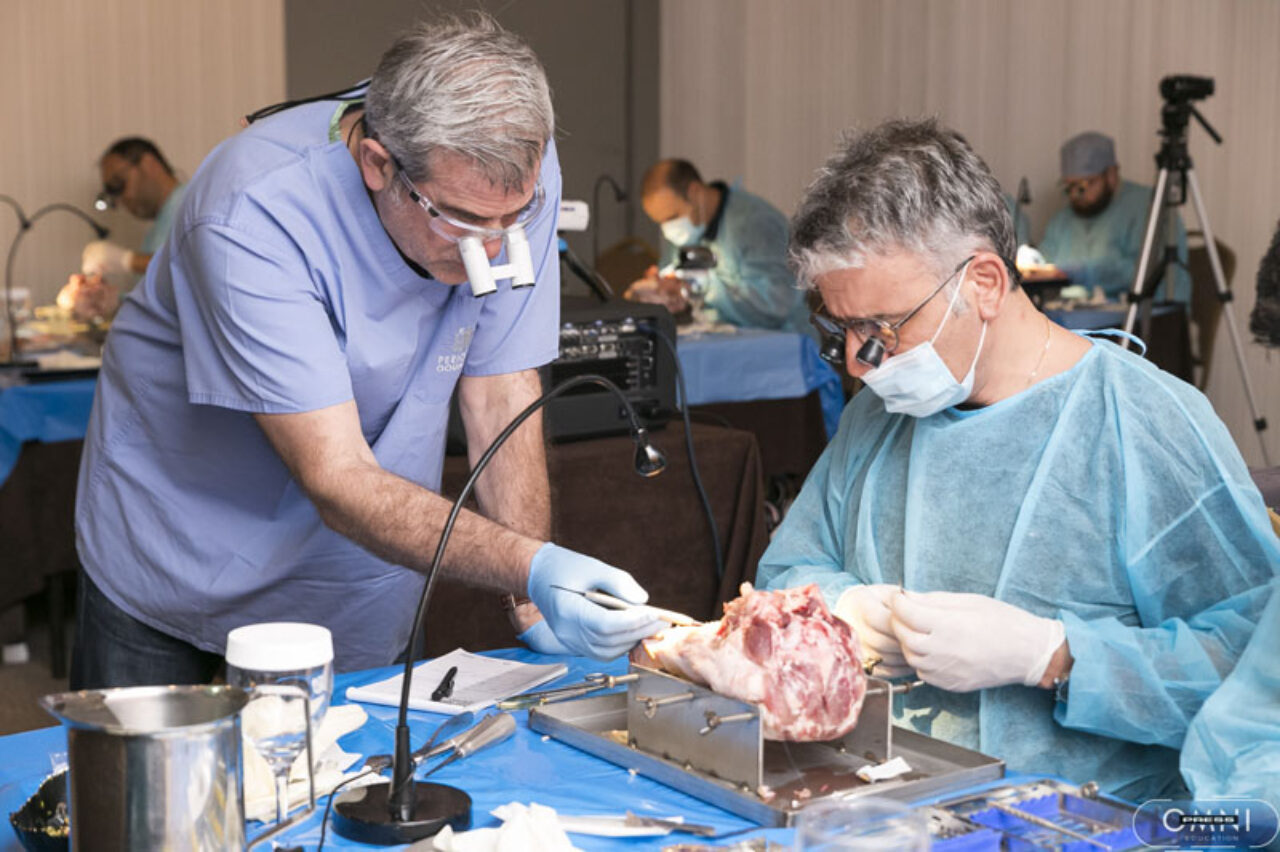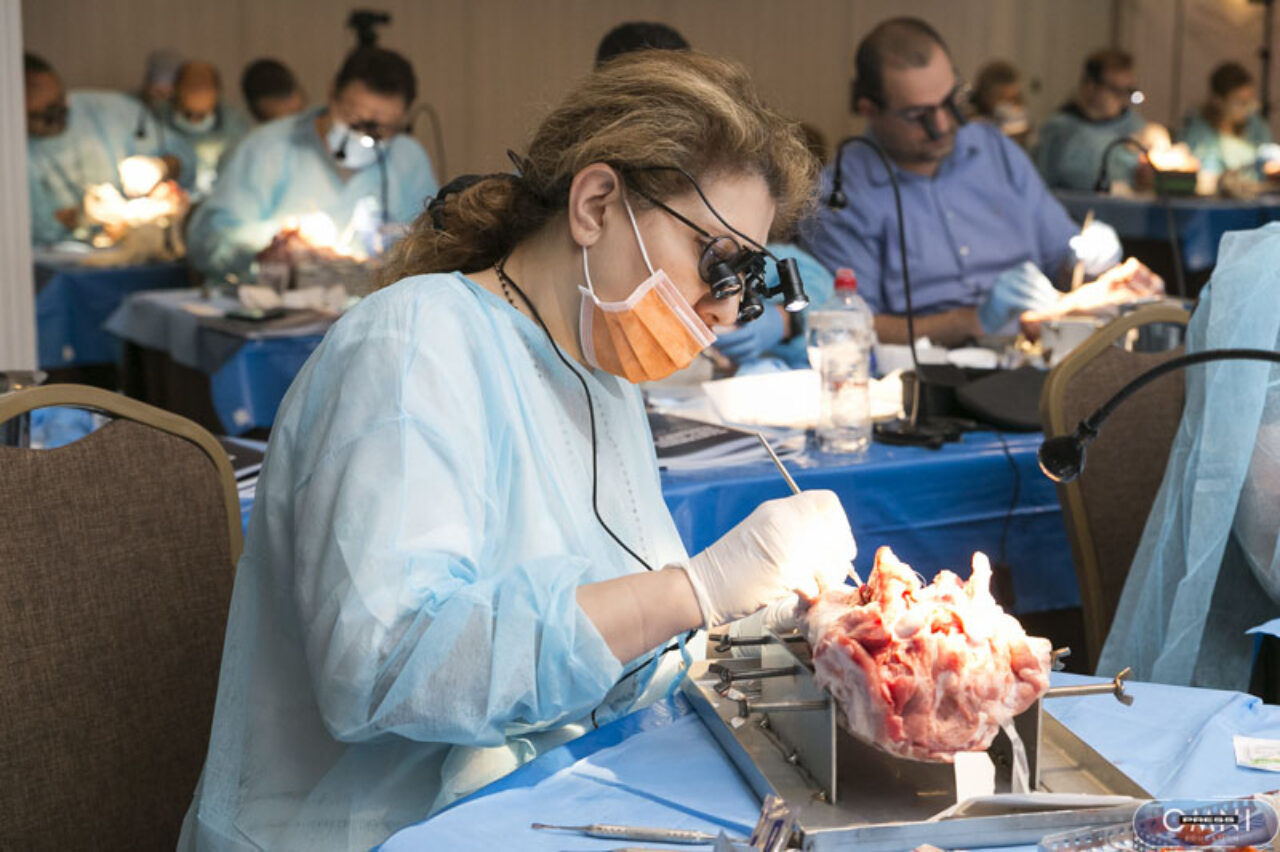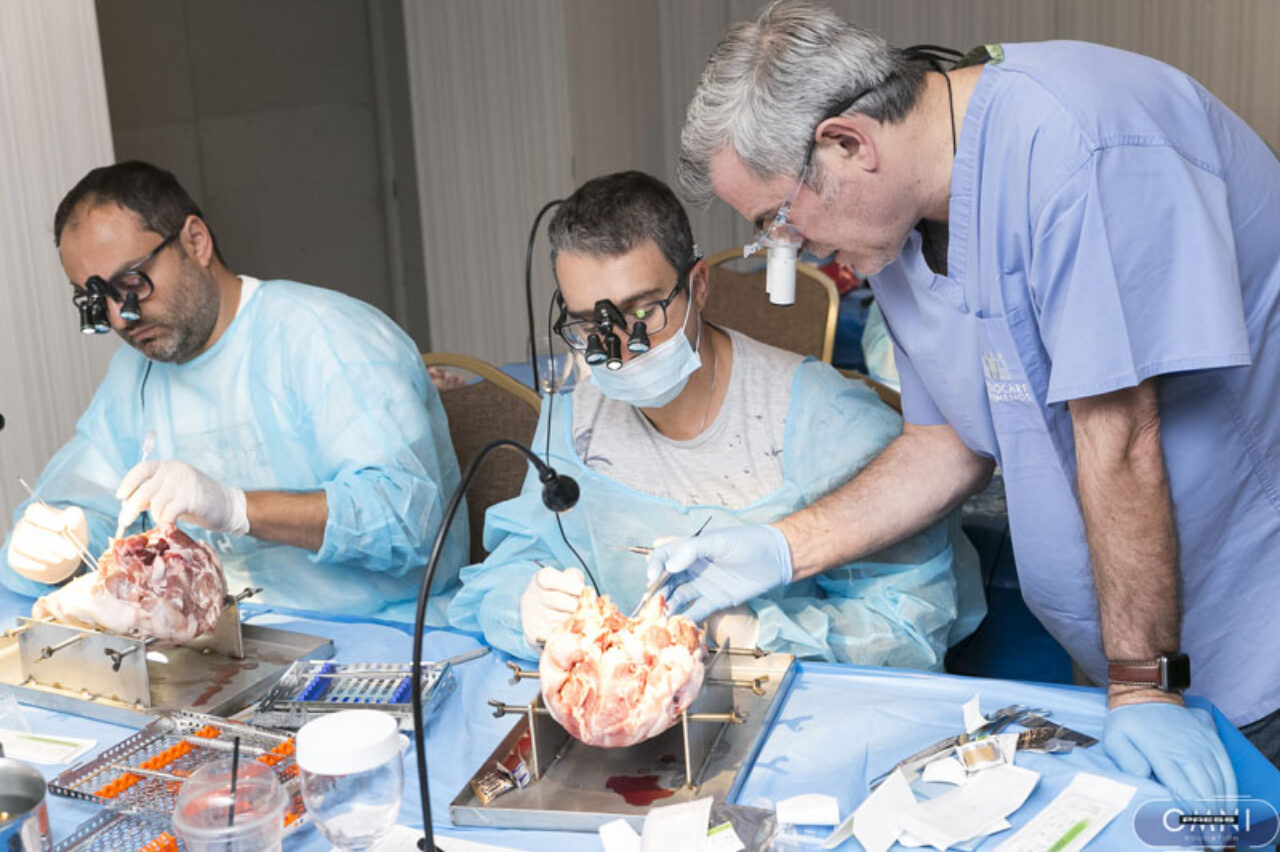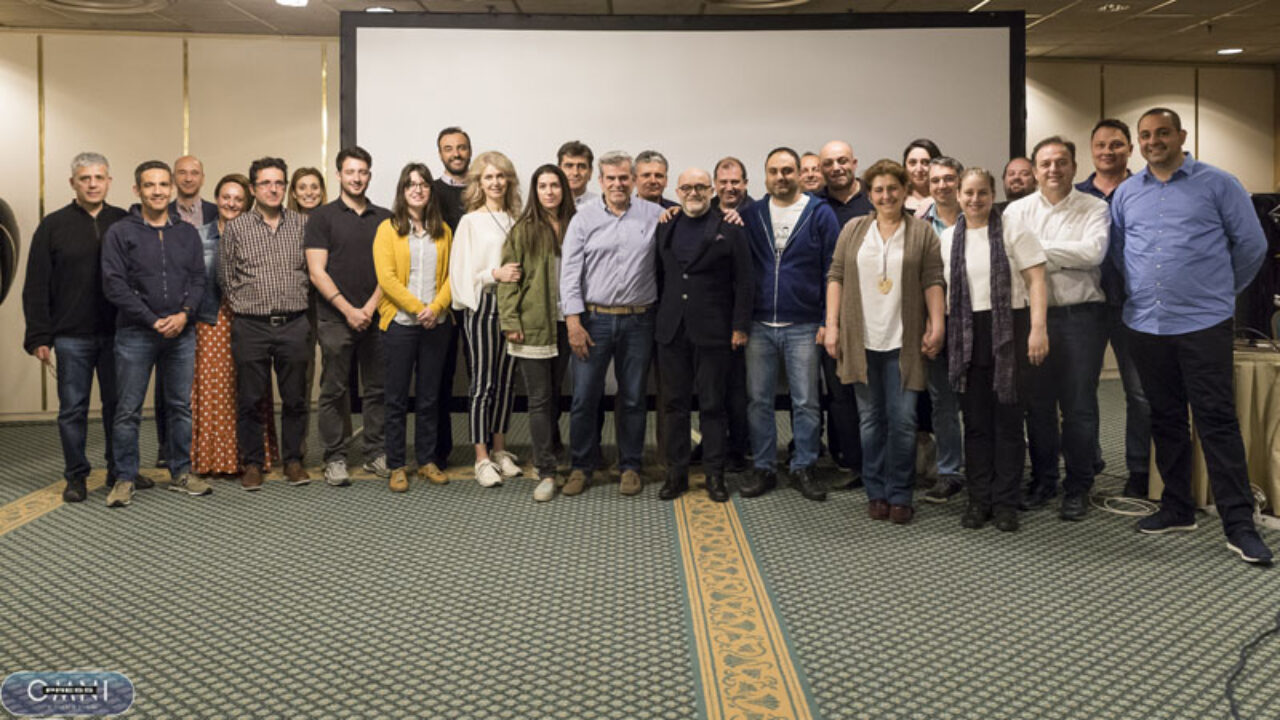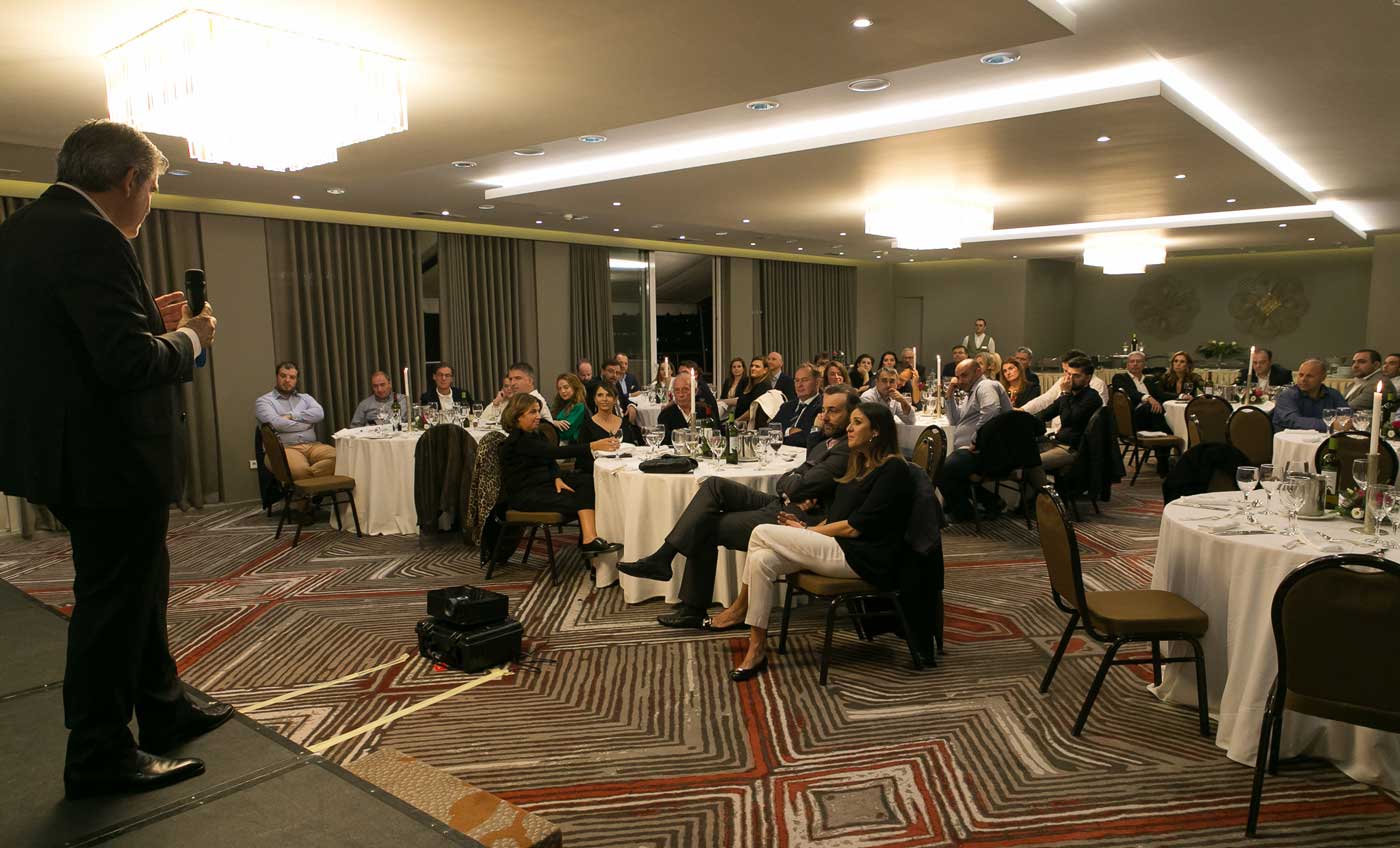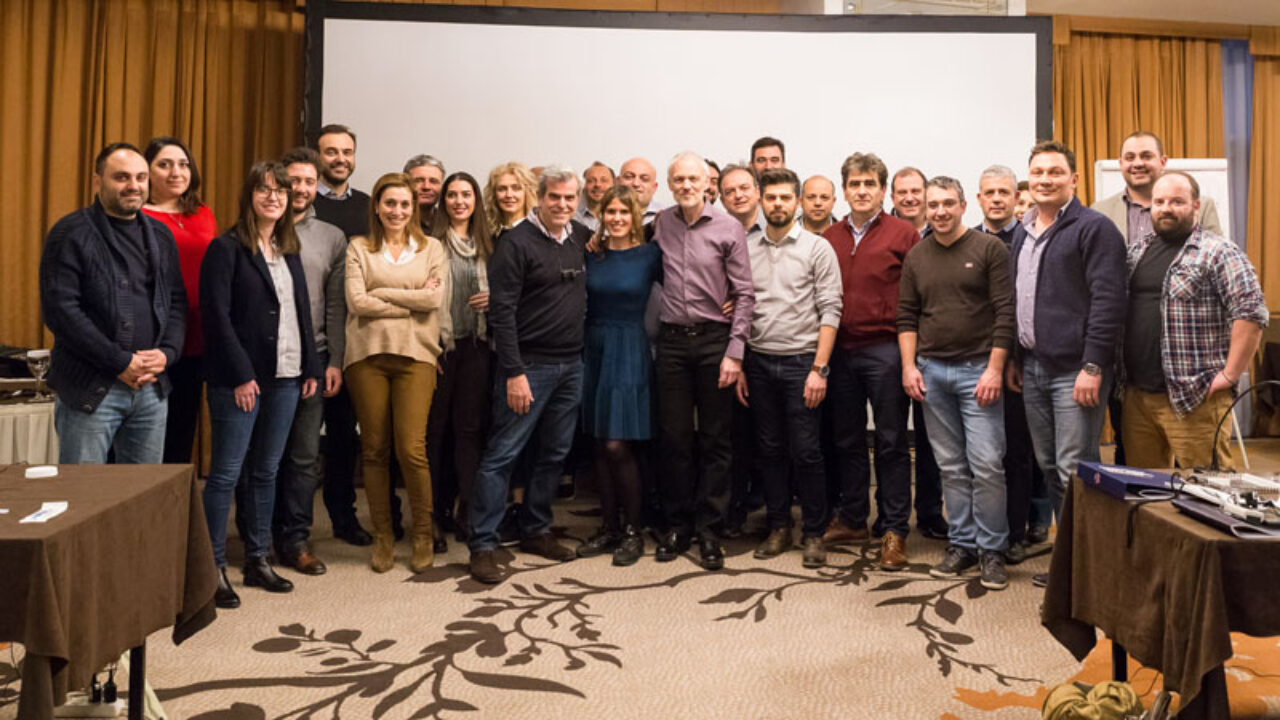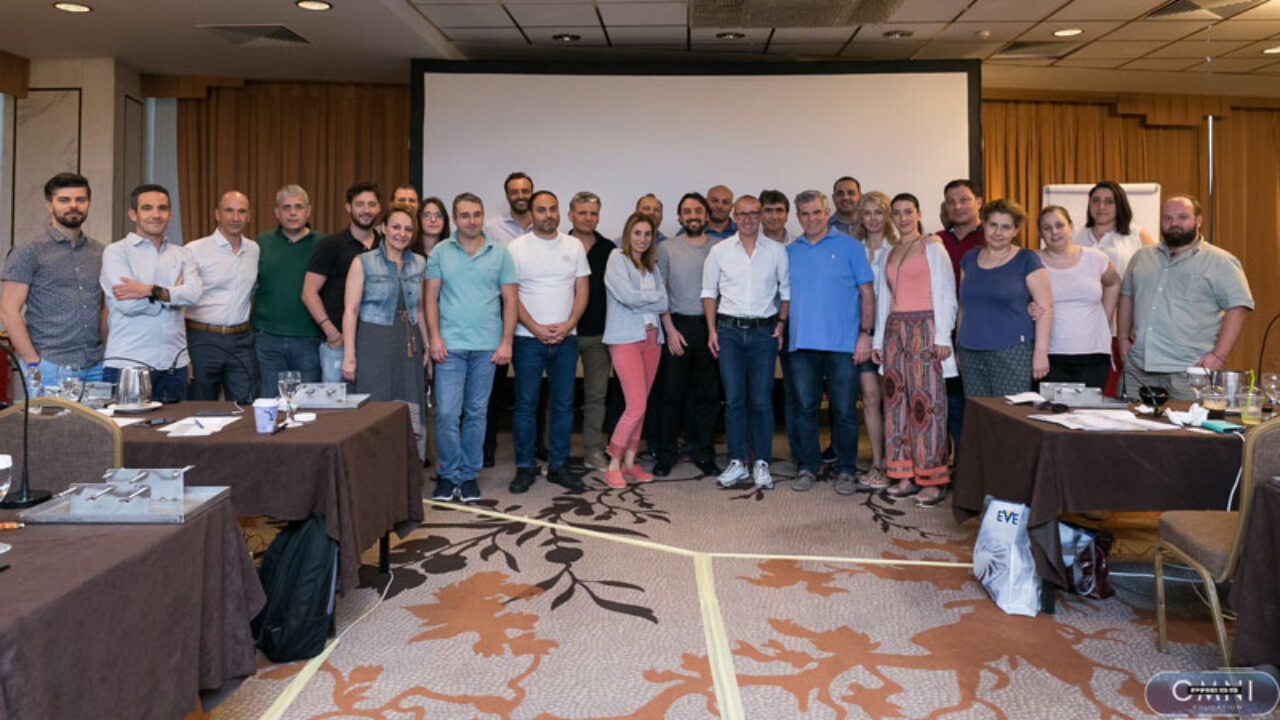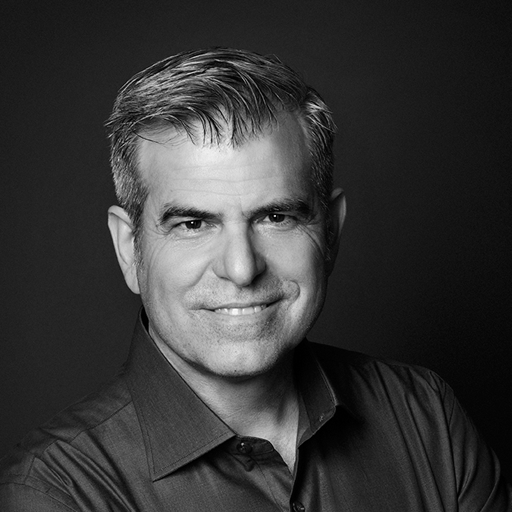Carlo Monaco | Egon Euwe | George Goumenos | Giovanni Zucchelli | Giulio Rasperini | Martina Stefanini | Michael Stimmelmayr | Otto Zuhr | Rino Burkhardt
The aim of these seminars is to provide knowledge on the appropriate surgical management of oral soft tissues. The trainees gain a solid foundation of knowledge on the biology of healing and receive comprehensive training in the basic surgical principles and surgical techniques, along with the required equipment and materials used.
The seminars aim to render the application of surgical techniques in everyday dentistry more user-friendly and help dentists achieve more predictable and effective results. Soft tissue surgery is presented in three 2-day seminars. Each seminar includes lectures, video presentations, hands-on demonstration on the jaw bone of a pig and attendance of live surgery sessions
ATHENS – GREECE
BOLOGNA – ITALY
12 DAYS OF MASTERING SOFT TISSUE SURGERY
4 MODULES
MODULE I
CONTEMPORARY SOFT TISSUE SURGERY FROM FLAP DESIGN TO WOUND CLOSURE
SOFT TISSUE QUALITY ENHANCEMENT AND INTERPROXIMAL ATTACHMENT GAIN
MODULE II
THE CORONALLY ADVANCED FLAP
SOFT TISSUE QUANTITY ENHANCEMENT AROUND TEETH AND IMPLANTS
PROSTHETIC MANAGEMENT AND TISSUE CONDITIONING FOR OPTIMUM AESTHETICS
MODULE III
TUNNELING TECHNIQUES ΙΝ SOFT TISSUE RECONSTRUCTION
SOCKET PRESERVATION AND TREATMENT STRATEGIES OF THE DEFECTIVE RIDGE
MODULE IV
MANAGEMENT OF THE ESTHETIC FAILURES AND COMPLICATIONS IN IMPLANTOLOGY
Share
CONTEMPORARY SOFT TISSUE SURGERY FROM FLAP DESIGN TO WOUND CLOSURE
SOFT TISSUE QUALITY ENHANCEMENT AND INTERPROXIMAL ATTACHMENT GAIN
08.30-09.00
Welcome Introduction
09.00-10.00
The Transition from Mucogingival Surgery to Periodontal and Implant Plastic Surgery
10.00-11.00
Basic Principles in Flap Design and Suturing
11.00-11:30
Coffee Break
11:30-13:00
The Full and Split Thickness Flap
Several Suturing Techniques (Hands on)
13:00-14:00
Lunch Break
14.00-15.30
The Free Gingival Graft Revised
15:30-16:00
Tea Break
16.00-17.30
The Free Gingival Graft for the Increase of Keratinization (Hands on)
17:30-18:00
Q and A
George Goumenos
09.00-10.30
The Structure & Function of the Periodontal Tissues
Wound Healing & Tissue Induction
10:30-11:00
Coffee Break
11:00-12:30
Suturing as a Key Indicator for Manual Skills (Hands on)
12:30-13:30
Lunch Break
13:30-15:00
Minimally-Traumatic Mucosal Surgery
15:00-15:30
Tea Break
15:30-17:30
Mucosal Flap Preparation & Wound Stabilization (Hands on)
17:30-18:00
Q and A
Rino Burkhardt
09.00-12.00
Live Surgery
12:00-13:00
Lunch Break
13:00-15:30
Diagnosing the Different Biotypes and their Impact on Tissue Characteristics.
The Biomaterials as Soft Tissue Substitutes. Current Status and Future Trends.
15:30-16:00
Tea Break
16:00-17:30
Interproximal Attachment Gain: The Challenge of Periodontal Regeneration
17:30-18:00
Q and A
Giulio Rasperini
THE CORONALLY ADVANCED FLAP
SOFT TISSUE QUANTITY ENHANCEMENT AROUND TEETH AND IMPLANTS
PROSTHETIC MANAGEMENT AND TISSUE CONDITIONING FOR OPTIMUM AESTHETICS
09.00-11.00
Surgical Treatment of Single Type Recession Defect in the Upper and Lower Jaw
11:00-11:30
Coffee Break
11:30-13:30
Surgical Treatment of Multiple Recession Defect in the Upper and Lower Jaw
13:30-14:30
Lunch Break
14:30-15:30
Treatment of Cervical Lesions Associated with Recessions
15:30-16:00
Tea Break
16:00-18:00
The Coronally Advanced Flap: Use of CTG for Root Coverage (Hands on)
Martina Stefanini
09.00-11.00
Treatment of Soft Tissue Dehiscence around Implants
11:00-11:30
Coffee Break
11:30-13:00
Mucogingival Approach for the Replacement of a Tooth Extracted for Dental Reasons
13:00-14:00
Lunch Break
14:00-15:30
Mucogingival Approach for the Replacement of a Tooth Extracted for Periodontal Reasons
15:30-16:00
Tea Break
16:00-17:00
Mucogingival Approach to Multiple Tooth Replacement with Dental Implants
17:00-18:00
Soft Tissue Management in Complex Cases
Giovanni Zucchelli
09.00-10.00
Risk Factors in Implant Prosthodontics
10.00-10.30
Coffee Break
10.30-11.30
Prosthetics Workflow from Wax-up Analysis to Computer-Assisted Planning
11:30-12:30
Immediate Loading: Management of the Provisional Restoration
12:30-13:30
Lunch Break
13:30-14:30
Delayed Loading: Management of the Provisional Restorations throughout the Treatment
14:30-15:00
Tea Break
15.00-16.00
Management of the Peri-implant Papilla in the Replacement of Multiple Adjacent Teeth in the Esthetic Zone
16.00-17:00
Prosthetic Management of the Malpositioned Implant
Carlo Monaco
TUNNELING TECHNIQUES ΙΝ SOFT TISSUE RECONSTRUCTION
SOCKET PRESERVATION AND TREATMENT STRATEGIES OF THE DEFECTIVE RIDGE
08.30-10:00
Hitting Hurdles in Soft Tissue Reconstruction
10:00-11:00
Exploring the Human Palate
11:00-11:30
Coffee Break
11:30-13:30
Gingival Recession Therapy in the Spotlight
13:30-14:00
Lunch Break
14:00-15:00
Minimally Invasive Flap Designs in Periodontal Plastic Surgery: Part I
15:00-15:15
Tea Break
15:15-16:15
Minimally Invasive Flap Designs in Periodontal Plastic Surgery: Part II
16:15-16:30
Q and A
Otto Zuhr
09.00-10.00
Ridge Alterations after Tooth Extraction
10:00-11:00
Socket Sealing with Autogenous Soft Tissue Grafts
The Single Incision Technique for CTG Harvesting
11:00-11:30
Coffee Break
11:30-13:00
The Palatal Pedicle Flap
13:00-14:00
Lunch Break
14:00-15:00
Socket Sealing with the CTG (Hands on)
15:00-16:00
Socket Sealing with the FGG (Hands on)
16:00-16:30
Tea Break
16:30-17:30
Socket Sealing with the Epithelialized-SCTG (Hands on)
17:30-18:30
Socket Sealing with the Palatal Pedicle Flap (Hands on)
18:30-19:00
Q&A
George Goumenos
09.00-12.00
Live Surgery
12.00-13.00
Lunch Break
13:00-14:00
The Epithelialized-SCTG for Socket Sealing and Root Coverage
14:00-15:00
Pontic Site Development
15:00-15:30
Tea Break
15:30-16:30
Anatomical Landmarks in Soft Tissue Surgery
16:30-17:30
Prevention and Treatment of Complications in the Donor Sites of Autogenous Soft Tissue Transplants
17:30-18:00
Q and A
Michael Stimmelmayr
MANAGEMENT OF THE ESTHETIC FAILURES AND COMPLICATIONS IN IMPLANTOLOGY
09.00-12.00
Live Surgery
12:00-12:30
Coffee Break
12:30-13:30
Etiology of the Esthetic Failures in Implantology
13:30-14:30
Lunch Break
14:30-15:30
The “Ideal” Implant Placement
15:30-16:00
Tea Break
16:00-17:00
Treatment Planning of the “Highly” Esthetic Demanding Cases
17:00-17:30
Q and A
Egon Euwe
09.00-10.30
Differentiating the Failure from the Complication
10:30-11:00
Coffee Break
11:00-12:30
Osseointegrated Implant with Esthetic Failure: Restoration, Burial or Extraction?
12:30-13:30
Lunch Break
13:30-15:00 The Tunneling Technique: Use of CTG to Improve the Thickness of the Peri-implant Mucosa (Hands on)
15:00-15:30
Tea Break
15:30-17:00
Removal of an Osseointegrated Implant and Management of the Site (Hands on)
17:00-17:30
Q and A
George Goumenos
09.00-10.30
Case Presentation from the Participants
10:30-11:00
Coffee Break
11:00-12:30
Case Presentation from the Participants
12:30-13:30
Lunch Break
13:30-15:00
Treatment Planning in Complex Cases with the Experts (Part I)
15:00-15:30
Tea Break
15:30-17:00
Treatment Planning in Complex Cases with the Experts (Part II)
17:00-17:30
Q and A
EGON EUWE
GEORGE GOUMENOS
